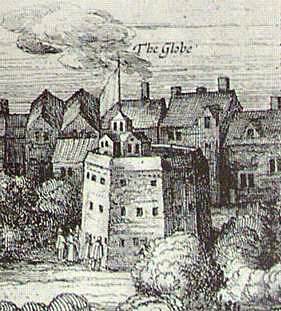The first Globe
This view of the first Globe by the Dutch engraver J.C. Visscher was printed in 1625, but must be taken from an earlier drawing, since the first Globe was burnt to the ground* in 1613 at the first performance of Shakespeare's Henry VIII. There is substantial evidence that Visscher simplified the appearance of the theater by portraying it as octagonal: most scholars now believe that it had twenty sides, thus making it seem more circular than in this engraving.
The first Globe was built in 1599 from the timbers of the old Theatre.
One of the first plays performed at the Globe, in September 1599, was Julius Caesar. Thomas Platter, a Swiss traveller, visited a performance: "[ I ] saw the tragedy of the first emperor Julius Caesar with nearly fifteen characters very well acted. At the end of the comedy [!] they danced* gracefully. . . , two dressed in men's and two in women's clothes."
The flag of the Globe depicted Hercules with the world on his shoulders. The playhouse motto was "Totus mundus agit histrionem," roughly translated as "All the world's a stage." See Jacques' well-known aria on the subject, As You Like it, 2. 7. 138-65.
Footnotes
-
How to put out a fire
In a letter dated 2 July 1613, Sir Henry Wootton recounted: "yet nothing did perish but wood and straw, and a few forsaken cloaks; only one man had his breeches set on fire, that would perhaps have broiled him, if he had not by the benefit of a provident wit put it out with bottle ale."
-
Graceful dancing
Platter is describing a Jig--a comic song and dance routine often performed after plays, particularly tragedies, to send the audience home happy.
Interestingly enough, the great Greek tragedies seem similarly to have been followed by jigs, or "satyr plays."
